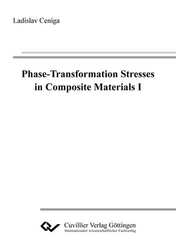| Departments | |
|---|---|
| Book Series (96) |
1378
|
| Nachhaltigkeit |
3
|
| Gesundheitswesen |
1
|
| Humanities |
2364
|
| Natural Sciences |
5406
|
| Mathematics | 229 |
| Informatics | 319 |
| Physics | 980 |
| Chemistry | 1363 |
| Geosciences | 131 |
| Human medicine | 243 |
| Stomatology | 10 |
| Veterinary medicine | 108 |
| Pharmacy | 147 |
| Biology | 835 |
| Biochemistry, molecular biology, gene technology | 121 |
| Biophysics | 25 |
| Domestic and nutritional science | 45 |
| Agricultural science | 1004 |
| Forest science | 201 |
| Horticultural science | 20 |
| Environmental research, ecology and landscape conservation | 148 |
| Engineering |
1793
|
| Common |
98
|
|
Leitlinien Unfallchirurgie
5. Auflage bestellen |
|
Advanced Search
Phase-Transformation Stresses in Composite Materials I (English shop)
Ladislav Ceniga (Author)Preview
Table of Contents, PDF (580 KB)
Extract, PDF (660 KB)
This monograph presents original mathematical models of phase-transformation stresses, which originate in isotropic matrix-inclusion composites during a cooling process, along with mathematical models of material micro-/macro-strengthening, as well as mathematical models of inter-/transcrystalline crack formation, which are induced by theses stresses, including mathematical definitions of critical limit states with respect to the material crack formation. The material strengthening and the limit states represent important phenomena in material science and engineering.
The mathematical models are determined for two types of real two-component materials, which consist of isotropic ellipsoidal precipitates in isotropic crystalline grains (e.g., matrix-precipitate composites) and of two types of ellipsoidal isotropic crystalline grains (e.g., dual-phase steel). The mathematical models results from fundamental equations of mechanics of a solid continuum, as well as from the principle of minimum potential energy.
In case of basic research, the results of this monograph can be incorporated to mathematical, computational and experimental models of overall materials stresses, overall material strengthening, interactions of energy barriers with dislocations and domain walls, etc. In case of engineering practice, material engineers can determine such numerical values of microstructural parameters of real two-component materials to obtain maximum values of material strengthening, and to define the critical limit states with respect to the crack formation in the matrix and the ellipsoidal inclusion. The material engineers can thus develop suitable technological processes, which result in such microstructural parameters to obtain maximum strengthening, and to avoid the crack formation.
This monograph is suitable for university under-/postgraduate courses on analytical material mechanics. The fundamental equations, along with the mathematical procedures, are explained and determined in detail. As a textbook on analytical material mechanics, this monograph is also suitable for non-specialists in mechanics of a solid continuum. Appendix presents such mathematical topics, which are required to perform the mathematical procedures., along with suitable mathematical procedures to perform the numerical determination.
| ISBN-13 (eBook) | 9783689528102 |
| Final Book Format | A5 |
| Language | English |
| Page Number | 116 |
| Edition | 1. |
| Publication Place | Göttingen |
| Publication Date | 2025-01-09 |
| General Categorization | Non-Fiction |
| Departments |
Natural Sciences
Mathematics |
| Keywords | mathematical model, material mechanics, composite material, phase-transformation stress, material strengthening, material crack formation, material limit state, analytical model, Matrix, Cartesian system, Cauchy’s equations, cell matrix, Zellmatrix, Kartesisches System, Materialrissbildung, Werkstoffmechanik, Verbundwerkstoff, Phasenumwandlungsspannung, Materialverfestigung, kartesisches System, Cauchy-Gleichungen, dual-phase steel, Zweiphasenstahl, elastic continuum, elastisches Kontinuum, elastic energy, elastische Energie, elastic energy density, elastische Energiedichte, equilibrium equations, Hooke’s law, Hooke'sches Gesetz, matrix-inclusion boundary, Matrix-Einschluss-Grenze, matrix-inclusion composite, Matrix-Einschluss-Verbund, phase-transformation strain, Phasenumwandlungsdehnung, phase-transformation stress, Phasenumwandlungsspannung, shear strain, Poissonsche Zahl, Poisson’s ratio, Scherdehnung, shear stress, Scherspannung, Wronskian’s determinant, Wronskian’s method, Wronskian-Verfahren, Young’s modulus, Elastizitätsmodul |








